Elements of Design: Key Points
- The 7 elements of design are the foundation of every interior.
- Space, line, shape, color, texture, light, and pattern each play a unique role.
- The principles of interior design guide how to use the elements.
- Combining all 7 creates balance, harmony, and emphasis in a room.
Introduction
The elements of design are the building blocks that interior designers use to transform empty rooms into breathtaking, functional spaces. By mastering these elements, you’ll be able to create interiors that feel balanced, harmonious, and uniquely personal. In this guide, we’ll explore the 7 essential elements of design to give you practical insights, tips, and examples you won’t find anywhere else.
Continue reading to discover what they are and how they can elevate your projects!
Before we dive into the details, it’s important to answer a simple question: what are the elements of design?
In a nutshell, the elements of design are the tools that interior designers use to shape how a space looks and feels. Think of them as the foundation. Every choice comes back to one or more of these elements, whether it’s paint color, furniture layout, or lighting.
The 7 elements of interior design are:
- Space
- Line
- Shape and Form
- Color
- Texture
- Light
- Pattern
Together, these elements help you create interiors that are not only beautiful but also functional and balanced. Mastering them allows you to take control of a room’s mood, flow, and overall impact.
Elements of Design vs. Principles of Interior Design
It’s easy to confuse the two, but elements and principles of design are not the same. Understanding the difference is key!
- Elements of Design = the building blocks. These are the physical tools you use, like space, line, shape, or color.
- Principles of Design = the rules for how you use those tools. These include balance, emphasis, harmony, rhythm, and proportion.
Here’s an example:
- Lines (element) can be used to guide the eye toward a fireplace.
- Emphasis (principle) makes the fireplace the focal point of the room.
In other words: elements are what you use, principles are how you use them.
By combining the 7 elements with the principles of design, you can create interiors that feel intentional, inviting, and professional!
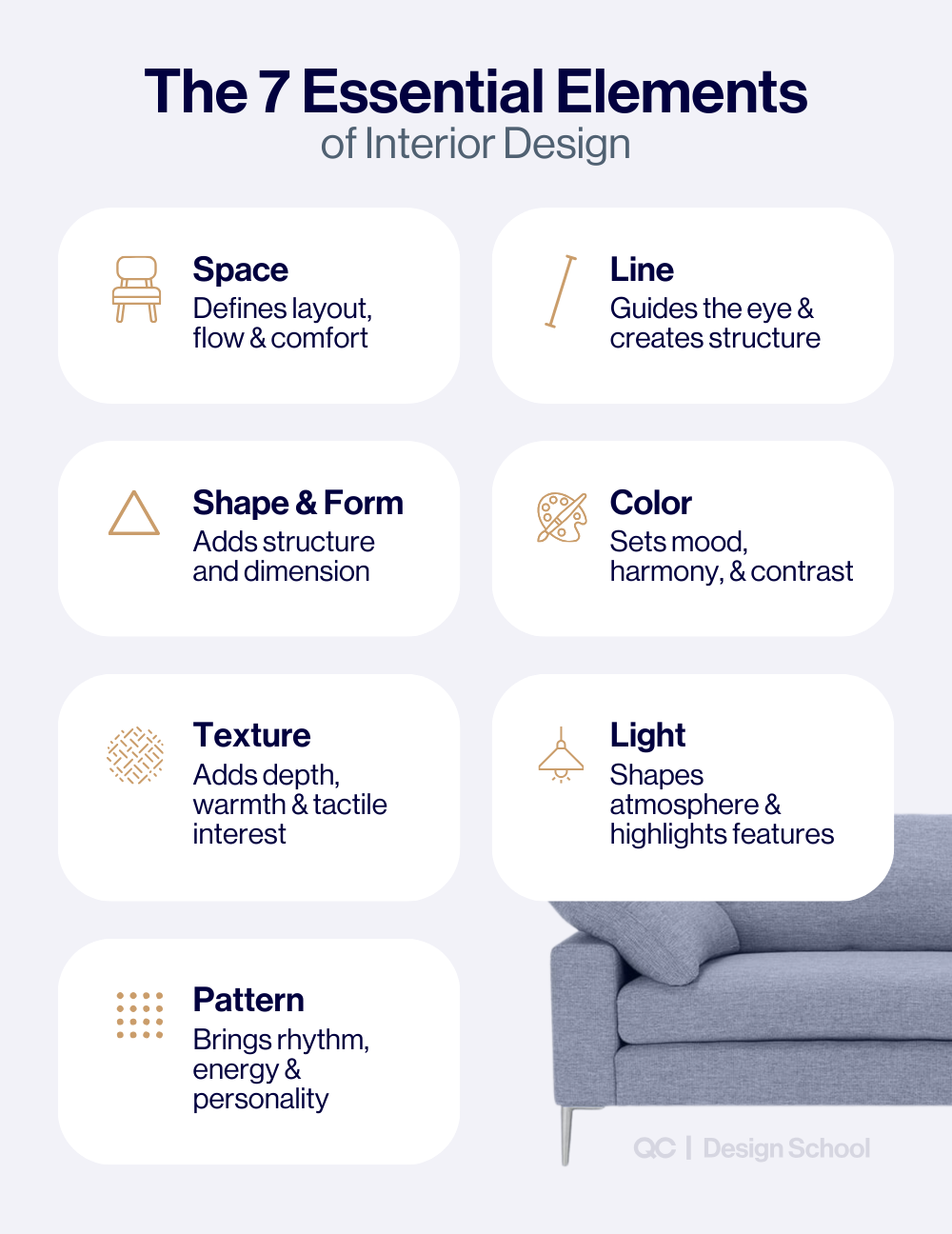
The 7 Essential Elements of Interior Design
The 7 elements of design work together to create interiors that feel balanced, harmonious, and unique. So, let’s look at each one in detail and explore how you can use them in your own projects.
1) Space in Interior Design
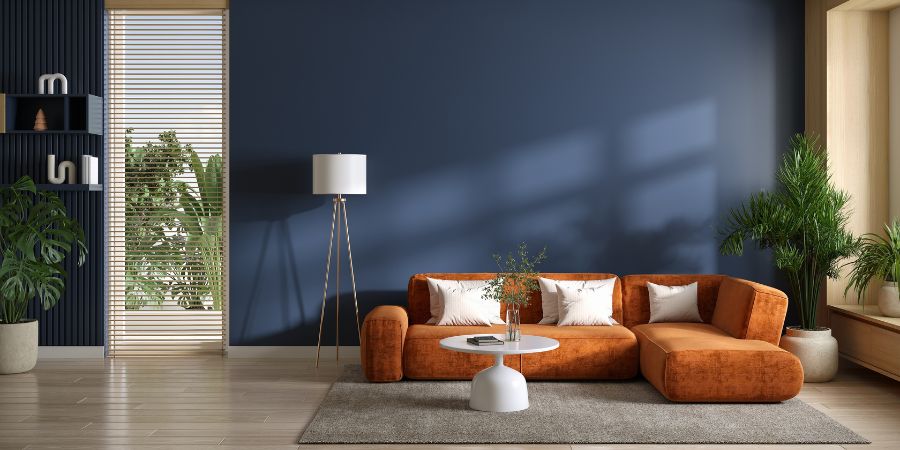
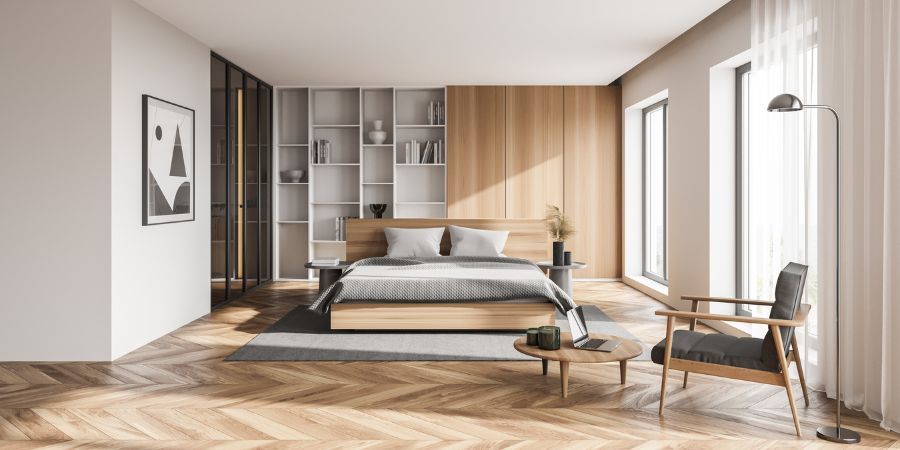

Space is the foundation of every design project. It’s the canvas on which all the other elements are built. When we talk about space in interior design, we mean the physical area inside a room—both what’s filled AND what’s left empty.
There are two types of space you need to think about:
- Positive space → the area taken up by furniture, decor, or architectural features.
- Negative space → the empty areas around and between those objects.
A room that’s too crowded with positive space feels cramped. On the other hand, too much negative space can make a room feel cold and unfinished. The key is BALANCE!
How to apply space in your designs:
- Arrange furniture so that walkways feel open and natural.
- Use rugs or lighting to “zone” areas in open-plan layouts.
- Leave breathing room between large pieces to avoid clutter.
- Experiment with scale. Bigger rooms can handle oversized furniture, while smaller rooms benefit from sleek, compact designs.
Why Space Matters:
Space defines how people move and interact in a room. When used thoughtfully, it makes interiors more comfortable and functional. Mastering positive and negative space is one of the quickest ways to elevate your design work!
Master The 7 Elements of Design
Earn your certification in Interior Design & Decorating right from the comfort of home!
2) Line Definition in Interior Design
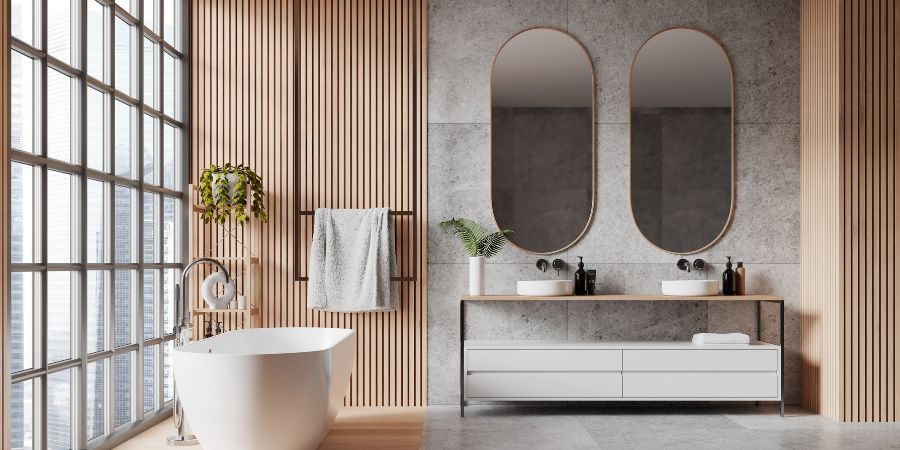
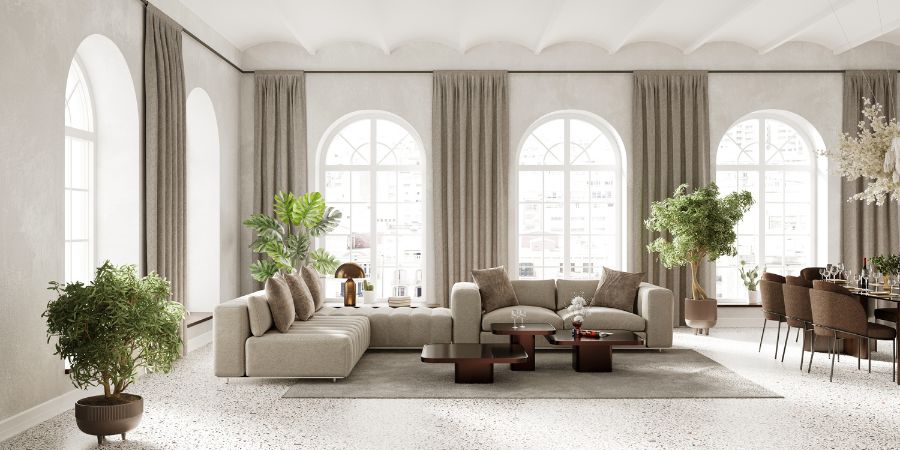
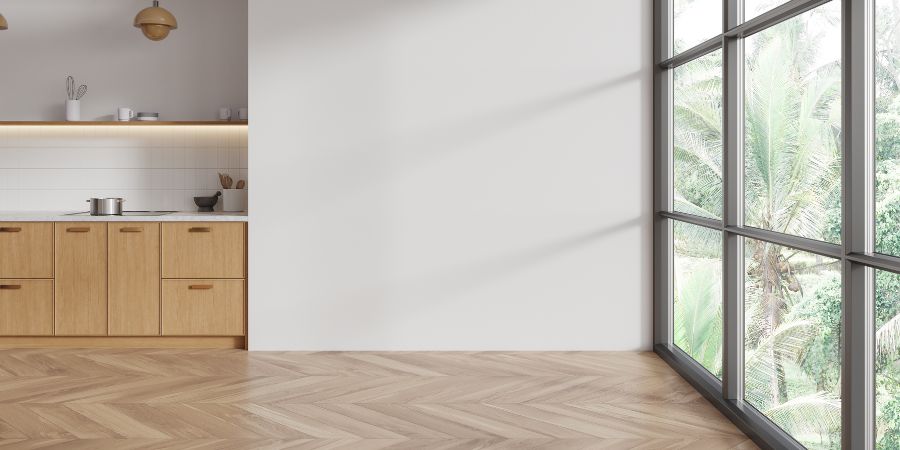
Lines are one of the most powerful tools in interior design. They guide the eye, define shapes, and create movement within a space. Thus, understanding line definition in interior design helps you control how a room feels and flows.
There are several types of lines to consider:
- Horizontal lines → Found in tables, beds, and shelves. They create a sense of stability, rest, and calm.
- Vertical lines → Found in doors, windows, and tall furniture. They bring height, strength, and a feeling of openness.
- Diagonal lines → Found in staircases, pitched roofs, or angled decor. They suggest movement and energy.
- Curved or organic lines → Found in arches, rounded furniture, and flowing patterns. They add softness and a natural touch.
How to apply lines in your designs:
- Use horizontal lines to make a small room feel wider and more grounded.
- Add vertical lines (like floor-to-ceiling curtains) to make ceilings seem taller.
- Introduce diagonal elements for drama and energy, especially in modern spaces.
- Balance straight lines with curved furniture or accessories to soften the look.
Why Lines Matter:
Lines aren’t just decorative; they shape how people see and move through a room. A strong line can lead the eye to a focal point, highlight architecture, or create rhythm in a design. By mastering line definition, you can turn an ordinary room into one that feels intentional and dynamic!
3) Elements of Design Shape & Form
In interior design, shapes and forms are literally everywhere. They give structure to a space and influence how we feel in it. When we talk about the elements of design shape, we mean the two-dimensional outlines you see (e.g., circles, squares, or triangles). When we talk about form, however, we mean three-dimensional objects that have depth (e.g., a sofa, vase, or architectural column).
There are two main categories to understand:
- Geometric shapes and forms → Structured and precise. Think rectangles, squares, and cylinders. These bring order and clarity to a room.
- Organic shapes and forms → Natural and free-flowing. Think leaves, waves, or irregular curves. These add softness and comfort.
How to apply shape and form in your designs:
- Use geometric shapes for modern, minimalist interiors.
- Add organic shapes in furniture or decor to create warmth and balance.
- Pay attention to proportion. Large rooms can handle bigger forms, while small rooms look best with lightweight, open shapes.
- Mix both types for contrast and interest.
Why Shape and Form Matter:
Shape defines the outlines of a room, while form adds dimension. Together, they influence balance, rhythm, and harmony. Moreover, they allow you to tell a story in your designs—whether it’s sleek and modern, soft and organic, or a balanced mix of both!
4) Color and the Psychology of Design
Few design elements influence emotions as strongly as color. In fact, many designers say color is the most powerful tool of all! This is because when you understand how we see/interpret color, you can then know how to properly use color in interiors, set the mood, create harmony, and highlight focal points.
The basics of color in design:
- Hue → The name of the color itself (blue, red, green).
- Value → The lightness or darkness of a color.
- Saturation → The intensity of a color (bold vs. muted).
Common examples demonstrating psychology of color:
- Blue = calm, peace, relaxation.
- Red = energy, passion, excitement.
- Yellow = warmth, optimism, cheerfulness.
- Green = balance, freshness, connection to nature.
- Neutrals (white, gray, beige) = timeless, flexible, sophisticated.
How to Choose a Color Palette
A strong design starts with a thoughtful color palette. Many designers follow the 60-30-10 rule:

This formula keeps the palette balanced and prevents one color from overwhelming the room.
How to apply color in your designs:
- Build a cohesive palette with a mix of dominant, secondary, and accent colors.
- Use contrast (light vs. dark, complementary colors) to create drama.
- Apply color harmony (analogous or monochromatic schemes) for a soothing, balanced look.
- Add bold colors in small doses, such as through accessories, pillows, or accent walls.
Common Mistakes To Avoid:
- Using too many bold colors at once, which can create chaos.
- Ignoring undertones (a “neutral” beige with a pink undertone may clash with cool gray walls).
- Forgetting to test colors under both natural and artificial light.
Why Color Matters:
Color influences mood more than any other design choice. It can make a small space feel larger, a cold room feel warmer, or a bland room feel full of life. Knowing how to use color psychology gives you the power to design interiors that connect with people on an emotional level.
Add Color Consulting Services To Clients
Pair our Color Consultant Course with ANY other course and get it at 50% off!
5) Texture for Depth and Dimension
Texture brings a room to life! For starters, it adds depth, interest, and warmth. Not to mention, without texture, even the most colorful or well-planned space can feel flat and unfinished. In the world of interior design, texture refers to both how something feels to the touch AND how it looks to the eye.
There are two types of texture:
- Tactile texture → How an object feels when touched (smooth silk, rough stone, soft velvet).
- Visual texture → How something appears to feel, even if it’s flat (a wallpaper that looks like wood grain).
How to apply texture in your designs:
- Layer different materials (e.g., combine wood, metal, fabric, and glass).
- Use rugs, pillows, and throws to add softness.
- Contrast smooth and rough surfaces for interest. For instance: pair a sleek marble countertop with rustic wood cabinets.
- Add natural materials like plants, stone, or woven baskets to create warmth.
Why Texture Matters:
Texture affects both how a space looks and how it feels. It creates comfort, dimension, and a sense of luxury. When you layer textures, you can transform a plain room into one that feels warm, engaging, and professionally designed!
6) Light as a Design Element
Light has the power to completely transform a space. It affects how colors appear, how textures are perceived, and even how large or small a room feels. In interior design, light is both a functional necessity and a creative tool.
There are two main types of light:
- Natural light → Sunlight coming through windows, doors, or skylights.
- Artificial light → Light from fixtures such as lamps, pendants, chandeliers, and recessed lighting.
Lighting for Small vs. Large Spaces
The size of a room changes how you should approach lighting.
- In small spaces, bounce light with mirrors, choose reflective finishes, and avoid heavy window coverings that block sunlight.
- In large spaces, use layered lighting to prevent dark corners. Combine overhead fixtures, wall sconces, and floor lamps to create warmth and balance.
Good lighting doesn’t just brighten a room—it ensures every element of design is seen at its best.
Ways to apply light in your designs:
- Maximize natural light with mirrors, sheer curtains, and light wall colors.
- Layer artificial lighting:
- Ambient lighting → general overall light in a room.
- Task lighting → focused light for reading, cooking, or working.
- Accent lighting → highlights artwork, architectural features, or focal points.
- Use dimmers to control mood and flexibility.
- Position lighting to create depth, highlight textures, and cast interesting shadows.
Why Light Matters:
Lighting shapes how we experience a space. A well-lit room feels welcoming, while poor lighting can make even the most beautifully designed room feel dull. By knowing how to properly use both natural and artificial light, you’ll ensure that EVERY element of your design shines at its best!
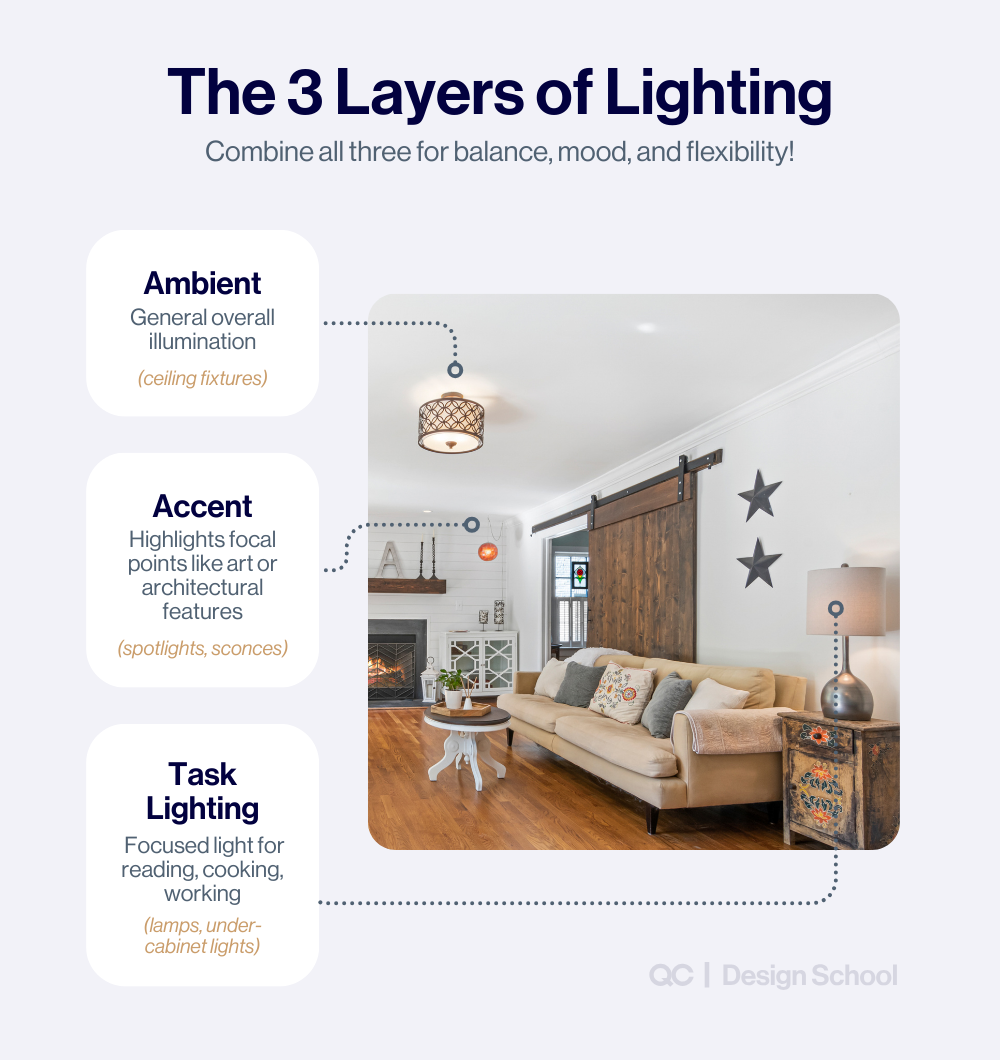
7) Pattern to Add Energy and Personality
Finally, pattern is the element that adds rhythm, movement, and personality to a room. Furthermore, it brings energy to otherwise plain spaces and can tie together all the other design elements. Patterns appear in fabrics, wallpapers, tiles, rugs, and even architectural details. They can be bold and dramatic or subtle and understated.
The key is using them intentionally!
Common types of patterns in design include:
- Stripes → clean, classic, and versatile.
- Floral → soft, natural, and often traditional.
- Geometric → modern, structured, and bold.
- Abstract → artistic, creative, and eye-catching.
How to apply pattern in your designs:
- Start small with pillows, throws, or artwork if you’re unsure.
- Use one dominant pattern and pair it with simpler designs to avoid overwhelming a room.
- Mix patterns carefully by sticking to a consistent color palette.
- Add cultural or global patterns to create interest and tell a story.
Common Mistakes With Pattern
Just keep in mind that pattern can quickly overwhelm a space if used incorrectly. So, avoid these mistakes:
- Mixing too many bold patterns in one room.
- Ignoring scale. For example, tiny patterns may disappear in a large room, while oversized prints can dominate a small one.
- Forgetting to balance pattern with solid colors to give the eye a place to rest.
Why Pattern Matters:
Pattern brings character and visual excitement to a design. It prevents a room from looking too flat or predictable. By weaving patterns into your projects, you create interiors that feel unique, memorable, and full of life!
How the Elements of Design Work Together
Mastering each design element individually is important. That said, the real magic happens when you combine them! Individually, each element is powerful. But when combined with principles like harmony, emphasis, and balance, they transform interiors into cohesive, professional-level designs that create balance, flow, and a sense of purpose in ANY space!
What Does Harmony Mean in Interior Design (and How To Create It)?
Harmony is when all the parts of a room feel like they belong together. It doesn’t mean everything has to match. Rather, it means the design feels consistent and unified.
Here are some ways you can create harmony in design:
- Stick to a cohesive color palette.
- Repeat shapes, lines, or textures throughout the space.
- Use consistent finishes, such as brass hardware or wood tones.
- Balance bold pieces with more subtle supporting elements.
One thing we highly recommend is choosing ONE design theme—like coastal, minimalist, or modern farmhouse—and letting it guide your choices. This creates natural harmony.
Using Emphasis in Interior Design To Draw the Eye
Additionally, every room needs a focal point. Emphasis in interior design means highlighting one area or feature so it stands out. Without emphasis, a room can feel aimless or cluttered.
You can create emphasis by:
- Highlighting a fireplace with contrasting paint or tile.
- Using bold artwork as the centerpiece of a wall.
- Placing a striking piece of furniture where the eye naturally lands.
- Directing attention with lines or lighting.
With that in mind, make sure to avoid too many competing focal points. One strong feature per room is usually enough.
Balancing Scale, Contrast, and Proportion
Lastly, balance ensures that no single element overwhelms a room. Instead, all parts work together to create comfort and stability.
To achieve balance:
- Distribute furniture and decor evenly across a space.
- Mix small, medium, and large pieces for variety.
- Contrast light and dark tones for depth.
- Use symmetry or asymmetry depending on the style you want.
One trick we recommend is snapping a photo of the room and looking at it in black and white. It’s easier to see if balance is off when you remove color from the equation!
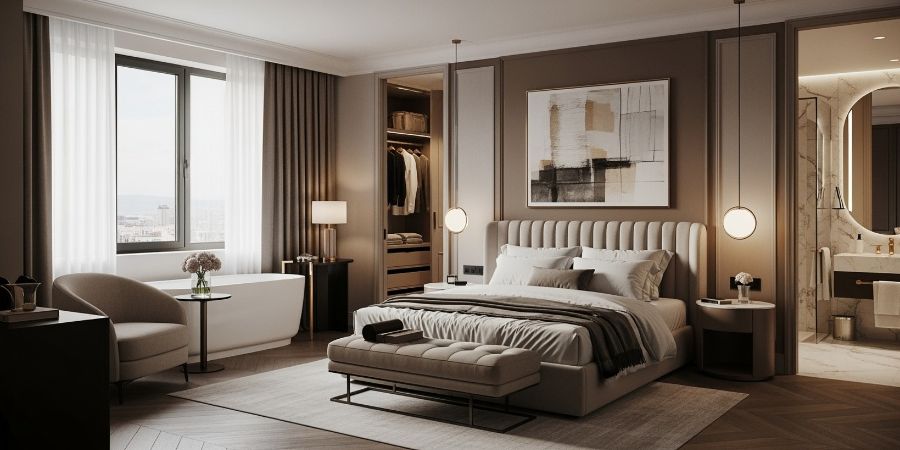
How To Use the Elements of Design in Interiors
Knowing the 7 elements of design is only half the journey… Next comes using them in real-life situations. Whether you’re working with a small apartment, a large open-plan home, or a tight budget, these elements will guide literally every choice you make.
By actually applying the 7 elements of design in different contexts, you can solve design challenges in any space. You can make a small room feel bigger, stretch a budget, and keep up with trends. These tools give you the flexibility to succeed—so let’s delve into that a bit more, shall we?
Small vs. Large Spaces
The size of a room affects how you apply design elements. Meaning, a design trick that works in a studio apartment won’t always work in a spacious loft.
In small spaces:
- Use vertical lines (like tall curtains) to make ceilings feel higher.
- Keep furniture compact and raised on legs to reveal more floor space.
- Choose lighter color palettes to open up the room.
- Add mirrors to reflect light and make the space appear bigger.
In large spaces:
- Break the room into zones using rugs, lighting, or furniture placement.
- Add oversized furniture or statement pieces so the space doesn’t feel empty.
- Layer textures and patterns to create intimacy.
- Use darker colors in some areas to anchor the room.
Here, you’ll always want to consider proportion. After all, a couch that feels right in a large living room may overwhelm a small one!
Budget-Friendly Design Tips
You also don’t need an endless budget in order to use the elements of design effectively. In fact, many of the most powerful techniques are simple and affordable!
Check out these smart ways to save:
- Update color with paint instead of replacing furniture.
- Rearrange existing furniture to improve space and flow.
- Add pattern with throw pillows or removable wallpaper.
- Layer inexpensive textures like cotton, jute, or faux fur.
- Use lighting strategically (e.g., floor lamps and LED strips can transform a space at a low cost).
Incorporating Modern Trends (Biophilic, Minimalist, and Sustainable Design)
Design trends come and go, but the elements of design are timeless. Still, knowing how to apply them to current styles keeps your work fresh and relevant.
Here are some popular trends today:
- Biophilic design → Bring nature indoors with plants, wood, stone, and lots of natural light.
- Minimalist design → Focus on clean lines, open space, and a neutral palette with carefully chosen accents.
- Sustainable design → Use recycled or eco-friendly materials, energy-efficient lighting, and durable finishes.
🔖 Want to dive deeper into sustainable design? Check out our full guide on Practical Tips for Eco-Friendly Interiors and learn how to make your spaces beautiful and environmentally conscious!
Expert Tips for Working with The 7 Elements of Design
Now that you better understand how the 7 elements of design can be applied in real-world scenarios, let’s take a look at how to apply them confidently. Here are 5 quick tips that can help you get started:
Tip #1 – Start with one element at a time.
Trying to master all 7 at once can feel overwhelming. Instead, focus on one element—like color or space—and experiment with it in a single room. Once you’re comfortable, you can then begin layering in the others.
Tip #2 – Think about balance from the beginning.
Professional designers don’t add balance at the end; they plan for it from the start! So, before you choose furniture or paint, decide first where your focal point will be and how the other elements will support it.
Tip #3 – Use light to highlight your best work.
Even the most beautiful design details can be lost without the right lighting. Use accent lighting to showcase artwork, architectural features, or a statement piece of furniture.
Tip #4 – Layer textures for a lived-in look.
Rooms that feel “flat” are often missing texture. Try mixing smooth and rough, shiny and matte, soft and hard surfaces for a space that feels rich and inviting.
Tip #5 – Don’t ignore negative space.
Leaving some areas open allows the eye to rest and makes focal points stronger. A little restraint can make a BIG impact!
BONUS TIP: Use color to create an accent wall!
”“The point of an accent wall is to be a focal wall. The underlying root of seeing color is first about seeing dark against light—so that’s what you’re taking advantage of with an accent wall. From there, always put the accent wall in a place where you want others to see what’s right in front of it.”
Jane LockhartInterior Designer & Renovator, Author, and QC Design School Expert
Master the 7 Elements of Design With QC Design School
The 7 elements of design are the foundation of every interior. From space and line to color, light, texture, shape, and pattern, these building blocks give you the tools to create interiors that are not only beautiful but also functional and balanced. Mastering these elements takes practice. The more you experiment with them, the more confident you’ll become in creating harmony, emphasis, and flow in your spaces.
At QC Design School, we specialize in helping aspiring designers like you turn passion into a career. Our online design courses are flexible, affordable, and led by industry experts. You’ll learn how to apply the elements of design step by step, build a professional portfolio, and graduate with a certification that sets you apart.
”I've gained such valuable perspective and knowledge through my QC training. The practical assignments and feedback from the tutors helped me gain confidence in my abilities. QC can help you achieve your goals – whether you want to start a business, embark on a thriving career, or simply become a master of designing your own home.
Daniella De LucaQC Design School Multi-Graduate • Owner & Operator of Doodle in Disguise
👉 Ready to turn your love of design into a rewarding career? Explore QC’s online interior design courses today and start building your future as an interior designer!
FAQs About the Elements of Design
You’ve learned the essentials of the 7 elements of design. Still have questions? Here are answers to some of the most common ones people ask.
Which element of design is MOST important?
There isn’t a single “most important” element because each plays a unique role. However, many interior designers agree that space and color form the foundation of most projects. Space determines how furniture and décor fit together, while color sets the mood and emotional tone.
That said, the best designs come from using all 7 elements in harmony. When they work together, the result is a room that feels intentional, balanced, and complete!
Do I need to know the elements of design to become an interior designer?
Yes. They’re the foundation of professional design. By learning how to use them, you’ll be able to create interiors that are not only stylish but also functional and cohesive.
What does harmony mean in interior design?
Harmony in interior design means that all parts of a room feel like they belong together. It’s about unity, not uniformity. Harmony can be created by repeating colors, shapes, or textures throughout a space.
What does emphasis mean in interior design?
Emphasis in interior design is about creating a focal point. This could be a fireplace, a bold piece of artwork, or a statement light fixture. Emphasis draws the eye to one main feature so the room feels intentional and balanced.
What are examples of elements of design in real life?
Examples include:
- Using mirrors (space + light) to make a small room feel larger.
- Adding throw pillows in different fabrics (texture) to create comfort.
- Choosing a striped rug (pattern + line) to add rhythm to a room.
- Painting a feature wall in a bold color (color + emphasis) to highlight one area.

